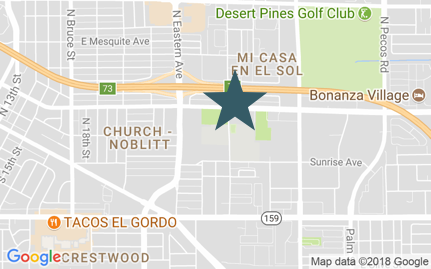First of a five-part series.
Sam crumples to the floor in a fit of anger. His hands are clenched, his lips quivering.
The second-grader’s meltdown occurs steps outside the cafeteria at Sunrise Acres Elementary School. He had kicked a teacher’s aide in the hallway, triggering a call for reinforcements. Assistant Principal Michael Dobbyn arrives seconds later.
“You’ve got a good heart. You’re not a mean person,” Dobbyn tells the sandy blond-haired boy. “I know that about you.”
They’re hunkered down in a carpeted alcove near the cafeteria entrance. On the other side of the wall is a glass display case featuring college memorabilia — a University of North Carolina football, a Penn State binder, a Clemson basketball, a Louisiana State University volleyball. In the center is a message designed to get students thinking about their future: “Which university will you attend?”
For some students, college or even graduation may seem like an improbable destiny. Take Sam, for instance. He has endured trauma and abuse and, for the past few months, has lived at an emergency shelter for children who have been taken out of their parents’ custody.
Now, he’s on his hands and knees on the carpet as Dobbyn coaxes him into eating.
“Oranges? Carrots?” he asks.
Sam shakes his head but nibbles on chicken tenders and fries shaped like smiley faces. Dobbyn continues talking softly to him, trying to soothe the boy who’s prone to daily outbursts. Often, Sam later apologizes, bewildered by his actions.
But what Sam is too young to realize, his teachers and principals know all too well: Children carry their emotional baggage into the classroom, making learning difficult and teaching complicated.
Maybe it’s the stress of a fractured family. Or lack of food. Or frequent moves. Or homelessness. Or neighborhood violence. Or an unspeakable trauma. Whatever the root cause, its aftermath ripples through school campuses across the Las Vegas Valley — and nation, for that matter — creating an environment that’s about more than just reading, writing and arithmetic.
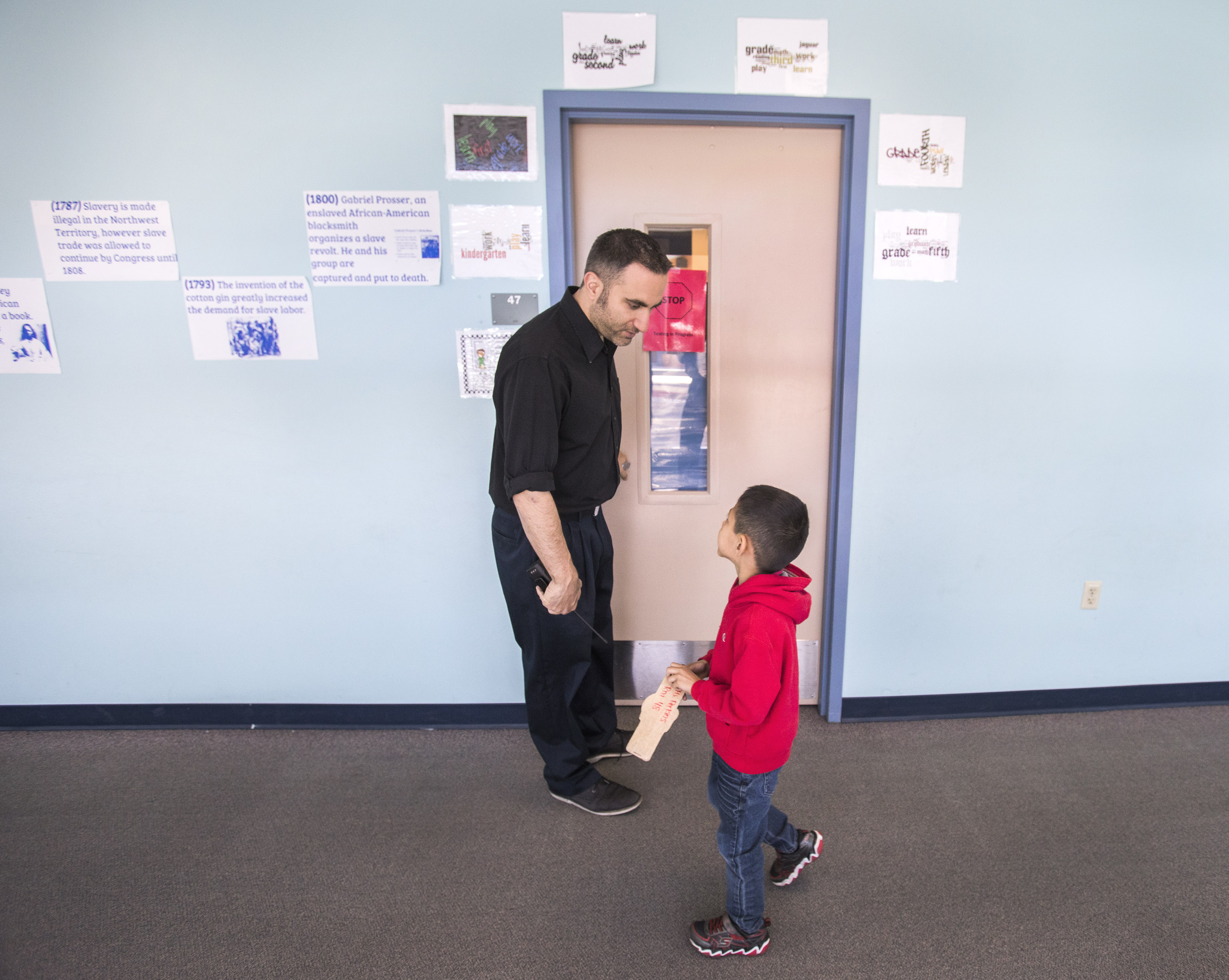

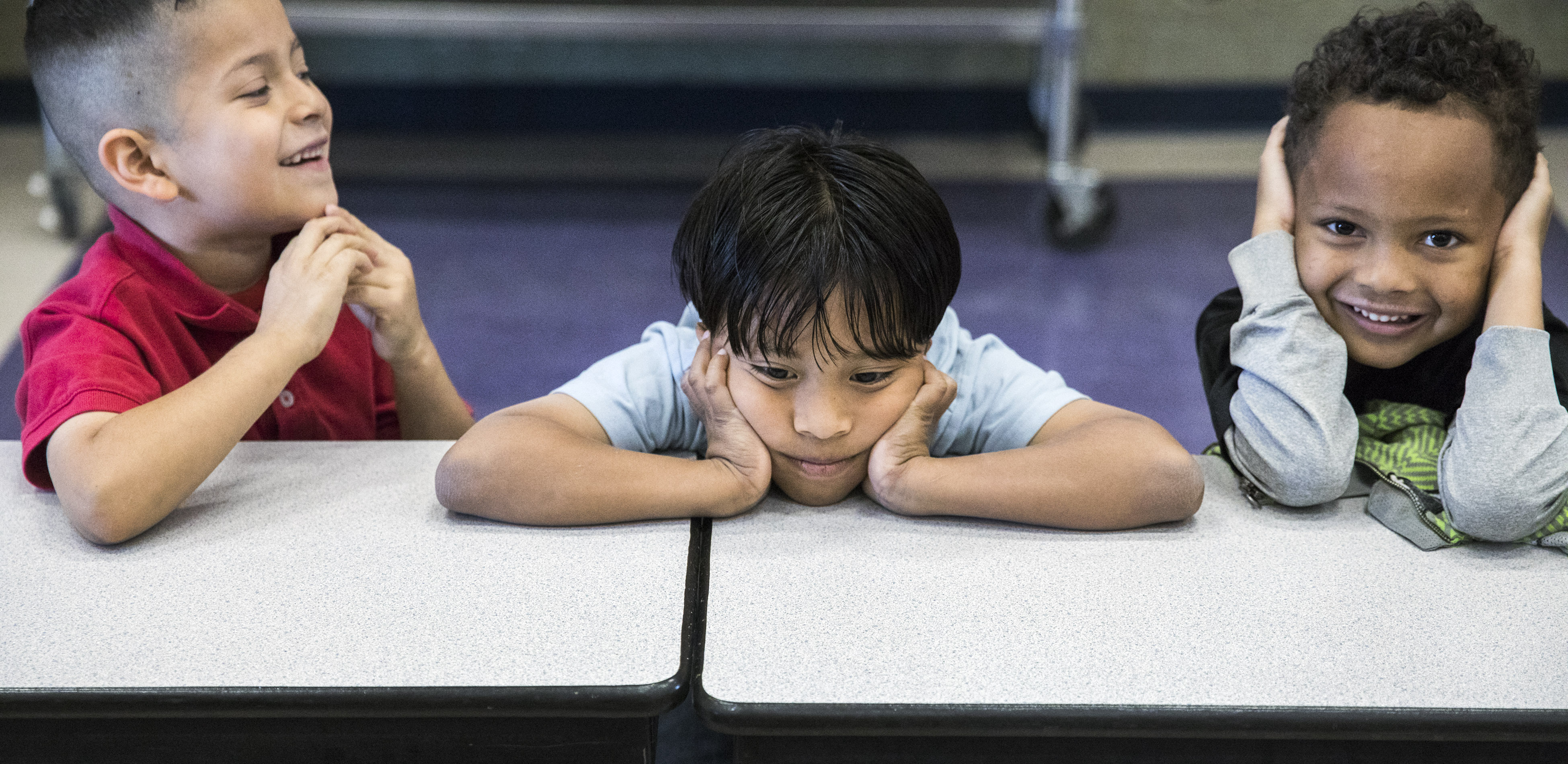
Top photo: Assistant Principal Michael Dobbyn talks to a student in the hallway on April 16, 2018. Middle: University banners hang in the hallway on March 9, 2018. Bottom: Students sit in the cafeteria after having breakfast on April 16, 2018.
That reality doesn’t translate to lowered expectations. The public school, a place of refuge for some and community hub for many, harbors the same mission it has for decades: Provide children, no matter their background, the best education possible. But the daily challenges educators encounter, at Sunrise Acres and elsewhere, make that no easy feat.
On this day, Sam eventually stands, grabs his kicked-off shoes and shuffles into the lunchroom, carrying his milk carton with his mouth. Dobbyn and Principal Margarita Gamboa, who came to see if they needed her help, breathe a temporary sigh of relief.
The daily struggle pains the school administrators. Sam once asked Gamboa if he could live with her. Moments like that force the school leader to a place she rarely spends much time.
“I go back into my office and cry,” she says. “Why is this innocent child going through this?”
A troubled school
Sunrise Acres sits east of downtown Las Vegas, nestled in a largely Hispanic community dominated by apartment complexes and small, one-story homes.
Eastern Avenue, the north-south artery that runs the length of the valley, cuts through the school’s attendance zone and features businesses such as a 7-Eleven, Mexican bakery, beauty salon and auto mechanic advertising $25 tires. Across the street is the East Las Vegas Community Center, where hundreds gathered the day after President Trump announced plans to wind down the Deferred Action for Childhood Arrivals (DACA) program.
But much of the day-to-day foot traffic heads toward Sunrise Acres — one of the few schools named after its neighborhood rather than a notable person. Crossing guards usher parents and children across busy streets as they make their way to and from school. It’s also where families go for an occasional holiday meal, after-school dance or academic night.
The original building — now serving as a Clark County School District maintenance yard — opened in 1952. A replacement school debuted 16 years ago nearby on the same plot of land. Today, the school serves as home to a rotating cast of roughly 850 students as well as 93 full- and part-time staff members.
The city’s growth over the last decade made the school spill out beyond its walls. Fourteen portable classrooms now line its perimeter.
The new building in the aging neighborhood didn’t wipe "struggle" from the school’s vocabulary. Low test scores plunged Sunrise Acres into the bottom 5 percent of Clark County schools in terms of student achievement earlier this decade.
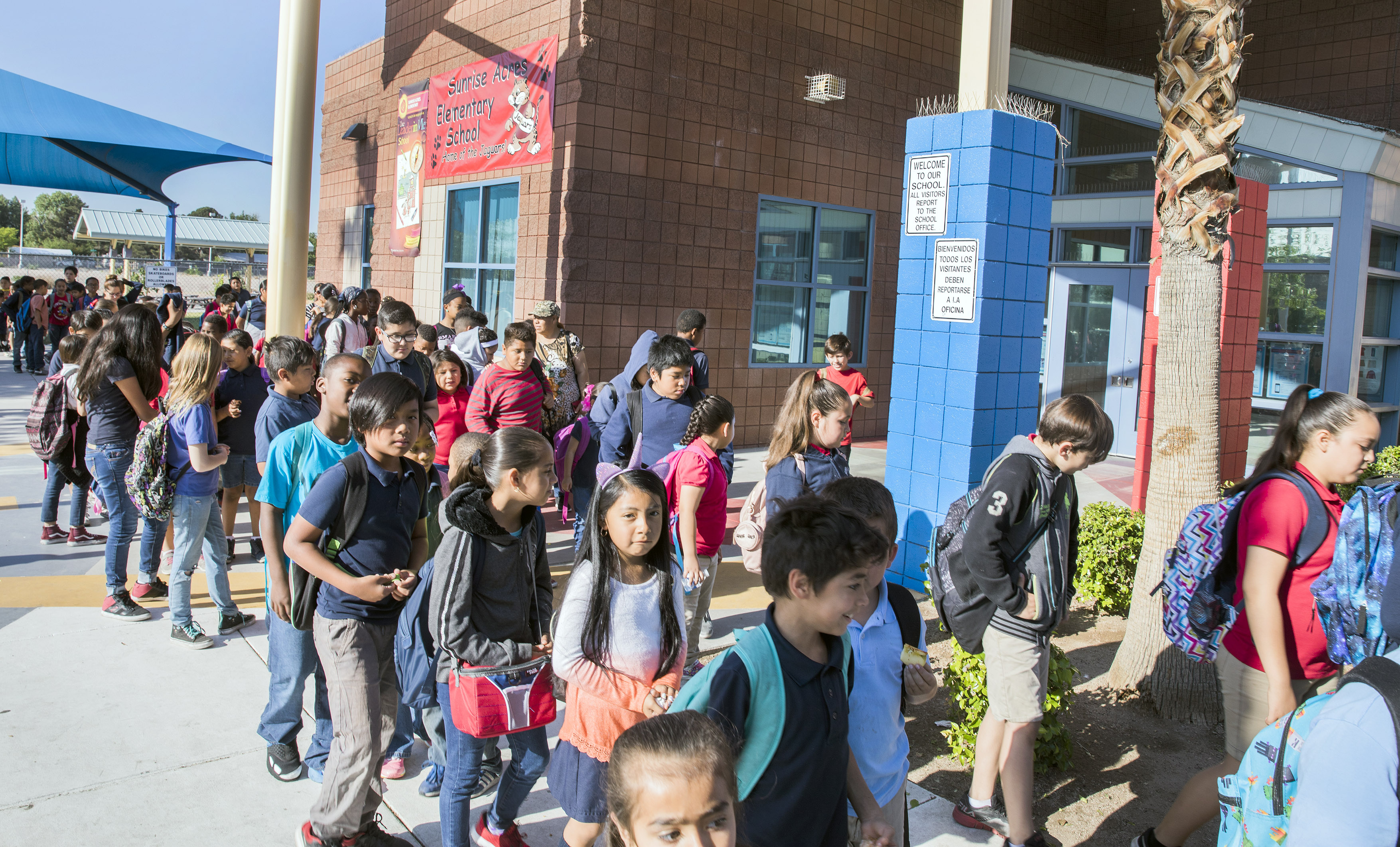
The percentage of Sunrise Acres students who could read or solve math problems at grade level trailed the districtwide average —often by double digits — on state standardized tests. In the 2011-2012 school year:
- Only 31 percent of Sunrise Acres third-graders were proficient in reading, compared with nearly 60 percent districtwide.
- More than half of the school’s fourth-graders — 57 percent — were reading proficiently, but that figure was still 13 percentage points below the district as a whole.
- Thirty-nine percent of fifth-grade students at Sunrise Acres were reading proficiently, compared with about two-thirds of fifth-grade students across the district.
- Roughly half of Sunrise Acres students in third grade (51 percent) and fifth grade (49 percent) scored proficient on math tests. Districtwide, 71 percent of students in those grades met the proficiency mark.
- The achievement gap between Sunrise Acres students and the district as a whole was slimmer for fourth-grade math proficiency — 67 percent and 73 percent, respectively.
The lackluster student performance landed the urban school in the district’s Turnaround Zone in June 2012. The program’s goal: Rapidly improve chronically underperforming schools by overhauling staff and injecting more resources.
A job opening posted soon afterward, catching the eye of a principal leading a school 19 miles south.
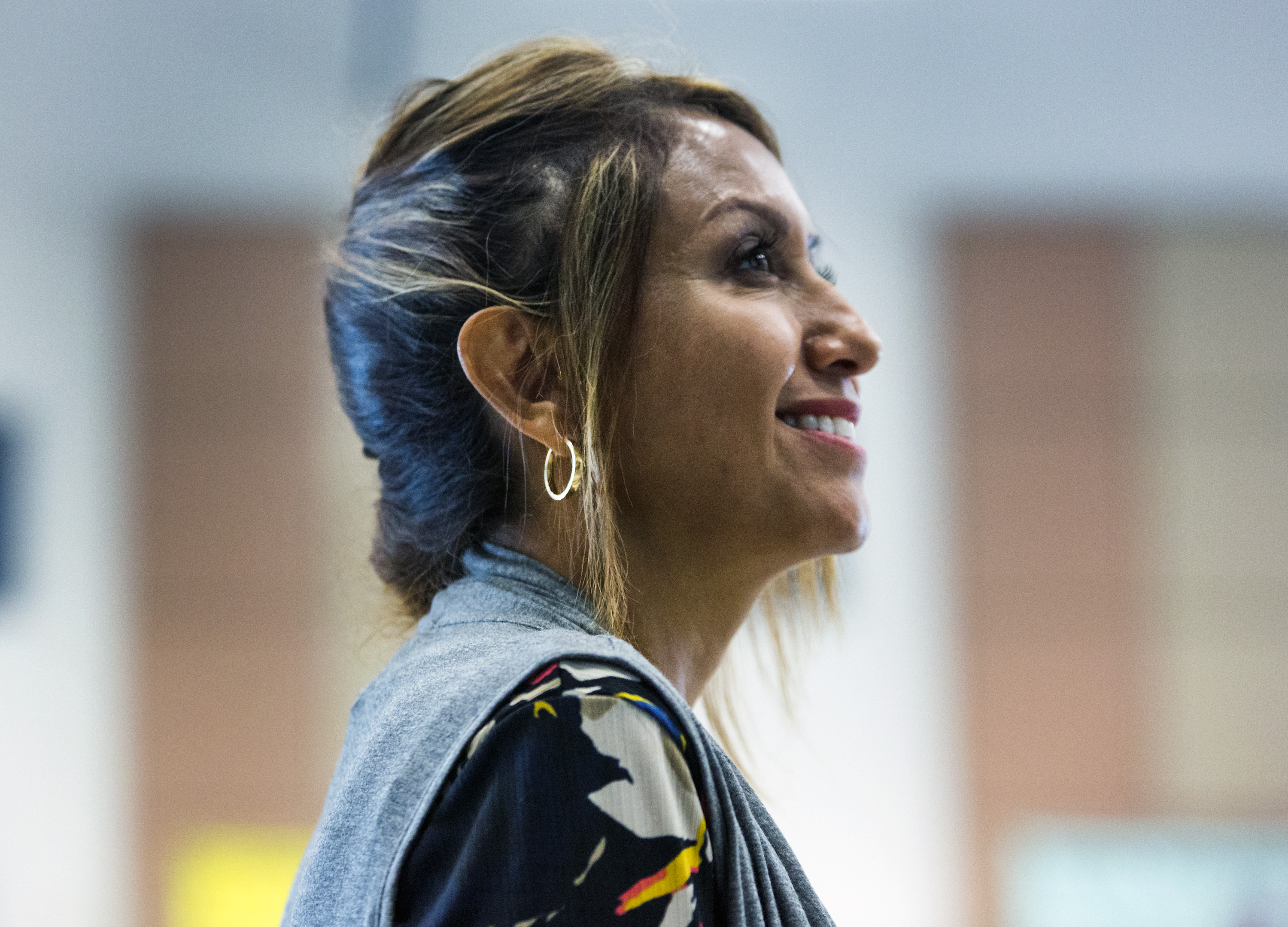
“If I get it,
it’s because it was meant to be.”
A full-circle journey
A kindergartener named Margarita Gamboa entered Sunrise Acres in 1976. She was quiet, afraid even, and knew very little English.
Decades later, she would return as a bilingual principal who’s reserved but not quiet. Gamboa considers it fate. She purposely didn’t tell district leaders making the hiring decision that she attended the school as a child.
“I said, ‘If I get it, it’s because it was meant to be,’” she says.
Born in El Paso, Texas, Gamboa arrived in Las Vegas as a 4-year-old with her mother and three brothers. Her mother followed family here, lured by the prospect of jobs. She found work as a maid at a downtown casino, and the family settled near Sunrise Acres. They lived mostly in apartments, including the complex just north of the school that’s filled with boxy, butterscotch-colored buildings. The dwellings seemed old back then, Gamboa says, as she recalls using pliers to turn on and off a water faucet inside one apartment.
But it’s what her single mother could afford on a modest, sometimes inconsistent, income. The family shared a bed and ate rice, beans and a pasta soup more often than meat. Cost of the soup: 30 cents per packet at the local Hispanic grocery store.
Their outings consisted of visiting a neighborhood park or swimming at the Roy Martin Middle School pool. On weekdays, her mother, who hadn’t finished third grade in Mexico, would walk Gamboa to school — an environment that initially seemed overwhelming because of the language barrier.
“You don’t know what’s going on,” Gamboa says. “You feel intimidated because you’re not sure if you are going to pronounce the word correctly.”
As Gamboa’s English fluency increased, so did her awareness about the happenings outside the family’s window. The loud pops they heard at night — and the reason the family sometimes slept huddled on the floor — were gunshots. Gang activity permeated their neighborhood. When Gamboa’s older brothers got swept up in it, her mother moved the family back to El Paso, placing a 700-mile barrier between the violence and her children’s futures.
A fourth-grader when the family moved, Gamboa finished high school in Texas. The urge to teach started young, fueled by helping her grandmother lead a summer Bible study.
But an unplanned pregnancy jeopardized those dreams.
Gamboa gave birth to her first child, a boy, at age 17. She told a trusted teacher about the pregnancy before her own mother. The same woman, who taught vocational classes, encouraged Gamboa to pursue college — baby and all — despite a high school counselor suggesting otherwise. The teacher even helped orchestrate a scholarship to make it happen.
The mentorship Gamboa, now 47, received from her vocational teacher has stuck with her to this day. It’s a reminder of the multi-layered role teachers often play in their students’ lives.
“If you want to be a teacher, you’re also a counselor. You’re also a psychologist. You’re also a mentor, a good listener,” she says. “Our teachers provide that for the students. It’s sort of that innate, artistic side of teaching. It’s not just numbers and letters.”
A 7-month-old baby, a gas-guzzling Caprice Classic, college coursework and a job proved too much. Gamboa dropped out.
Soon after, life brought her back to Las Vegas. A one-bedroom apartment near Eastern Avenue and Bonanza Road provided shelter for six family members: Gamboa, her husband, baby son, mother and two brothers. While Gamboa’s husband, who was a year younger than her, finished his senior year at Valley High School, she found work as a word processor for a hearing officer.
When her position was eliminated six months later, managers offered her a temporary job with the promise that it could turn permanent. She declined.
“I said, ‘No, I’m not going to do that anymore,’” she recalls. “‘I’m going to go back to school.’”
She graduated five years later from UNLV with a degree in education. Gamboa credits sheer determination and lucky breaks with making her second college attempt a success. An on-campus preschool helped her juggle motherhood and studies, while a job in the dean’s office provided a needed paycheck and easy access to the UNLV library. Even failing a calculus class didn’t sabotage her plans. Gamboa retook the class and, ultimately, decided to minor in math.
“Everything just kind of panned out,” she says. “It was an ideal situation.”
The Clark County School District hired Gamboa as a teacher after she graduated, starting her journey up the education career ladder. By 2012, she was principal of Reedom Elementary School in southwest Las Vegas. New stucco homes circled the school, with raw desert land just to the south. Many students came from educated families, easing the burden on teachers in some ways and elevating it in others.
The upshot: More students entered school knowing the basics.
The downside: Parents were quick to blame teachers when their child’s grades dipped.
“I guess I had had enough of my share of that whole, ‘I’m this person in town’ or ‘I’m that person’ or ‘I am going to go straight to the superintendent,’” Gamboa says.
The suburban school didn’t seem like the right fit anymore for the former Sunrise Acres student. So Gamboa gladly accepted when district leaders offered her the job running her childhood school. Now, she's the leader and her youngest child — a tall boy who loves karate — is the kindergartener.


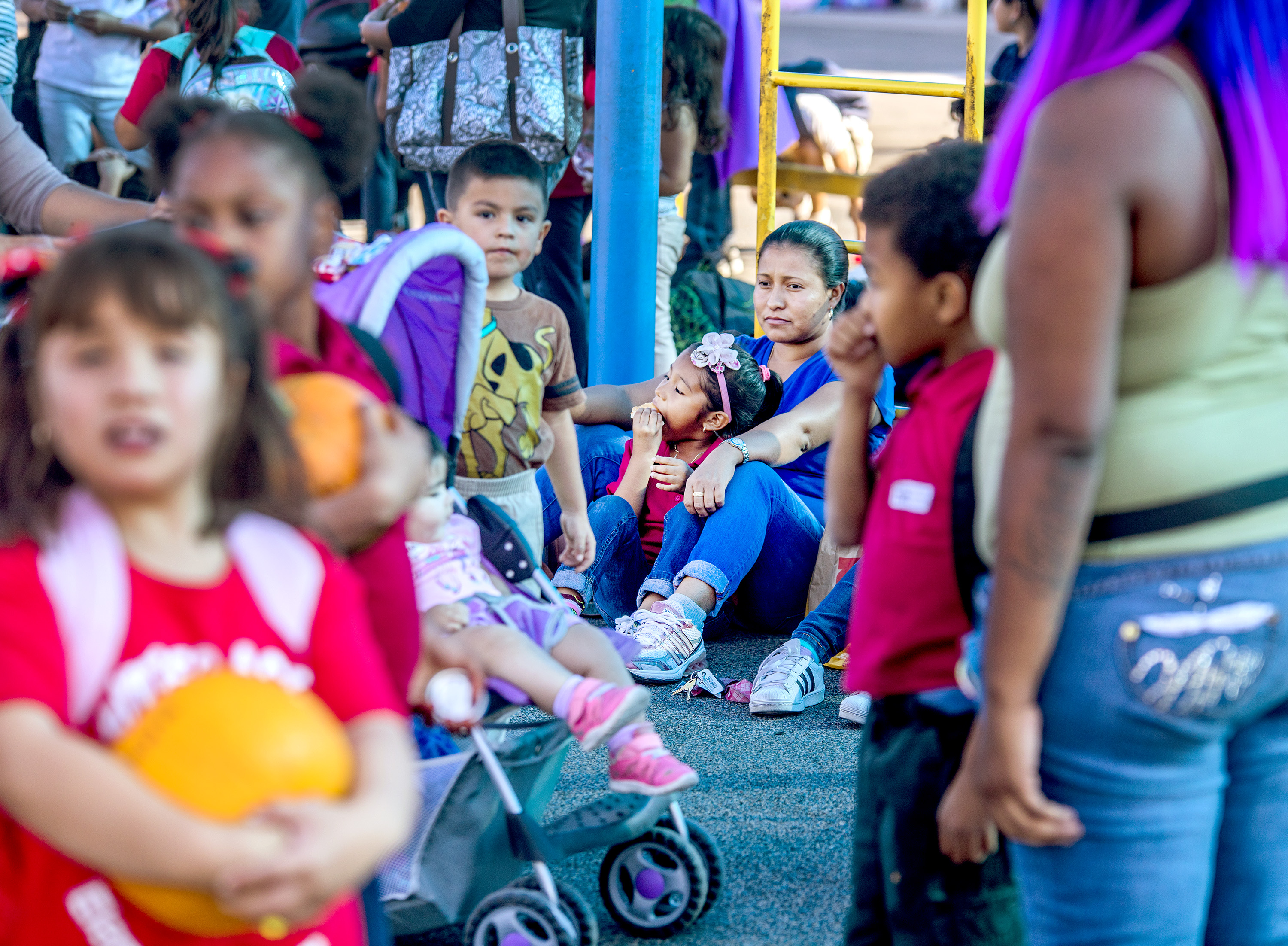
All photos: Students and their families gather for an after-school picnic on Oct. 25, 2017, to celebrate Sunrise Acres becoming a four-star school.
A new day
Superman, Wonder Woman and Power Rangers, among other fictional heroes and heroines, traipse the hallways of Sunrise Acres in mid-October. Gone are students' normal uniforms, replaced by getups worthy of their academic superpowers.
It’s a celebration day at the elementary school, which had received good news from the Nevada Department of Education a few weeks earlier: Students demonstrated so much growth on statewide tests that it propelled Sunrise Acres to four stars — up from two stars — under the new Nevada School Performance Framework.
Once a “Turnaround School” because of its dismal academic performance, Sunrise Acres is now a “Shining Star School” lauded for a being a high-performing site that serves a large number of students living in poverty. The designation comes during Gamboa’s sixth year leading the school and building a staff that churns out better readers and math problem-solvers.
“Everybody is more than willing to go above and beyond,” she says of her team.
The school’s “Cinderella”-like transformation took time.
When Gamboa took the reins as principal in 2012, she realized that several fourth-graders who started there as kindergarteners had earned perfect scores on standardized state tests. The discovery planted a seed of hope — and urgency.
She told her new staff that it had the ability to duplicate those success stories. It would involve tracking students’ progress, or lack thereof, much more closely.
“There will be systems in place that we bring that need to be followed, and they will be monitored,” Gamboa recalls telling her staff. “But there will be a day that I want you to be part of that winning team.”
That day didn’t come the first year. Half the staff left during the school’s initial year in the Turnaround Zone — a purposeful and common effect of the dramatic transformation program. Simply put, teachers not up to the challenge or those who didn’t agree with the turnaround process could transfer elsewhere, giving Gamboa leeway to hire new staff members who shared her vision.
Over time, the efforts of teachers who stayed or came aboard paid off. Gamboa says tracking student data more closely and arming children with healthy learning habits led to improved academic outcomes.
Nowadays, Sunrise Acres students are more on par with their peers across the district when it comes to reading and math skills. The biggest gap, according to standardized test results from the 2016-2017 school year, was on the third-grade reading assessment: The proficiency rate among Sunrise Acres third-graders trailed the districtwide rate by 8 percentage points.
Fourth-graders at Sunrise Acres, however, outperformed the district as a whole on the math assessment. Fifty-one percent were proficient in math, compared with 40 percent districtwide.
(Overall, the proficiency rates are lower than the 2011-2012 academic year because the state has since transitioned to more rigorous math and reading assessments, which are aligned to the new Nevada Academic Content Standards. The Smarter Balanced Assessments, commonly referred to as SBAC tests, require more critical thinking and written responses than the old tests.)
Jeffrey Geihs, the school associate superintendent who oversees the Turnaround Zone, says a combination of skilled leadership and highly effective teachers contributed to Sunrise Acres’ drastic improvement. The school’s success models what the district’s Turnaround Zone is supposed to achieve: a cultural transformation focused on improving the education delivered to students, which then translates to better test scores.
“People she hired had the fundamental belief that the success or failure of the school is always an adult issue — never kid issues,” he says.
Even so, the school serves some of the valley’s neediest children. Every student receives a free lunch, and 51 percent are considered English language learners.
And the school’s newly obtained four-star status doesn’t mean the work ends. The new challenge for Sunrise Acres staff: Maintain that academic progress and build upon it.
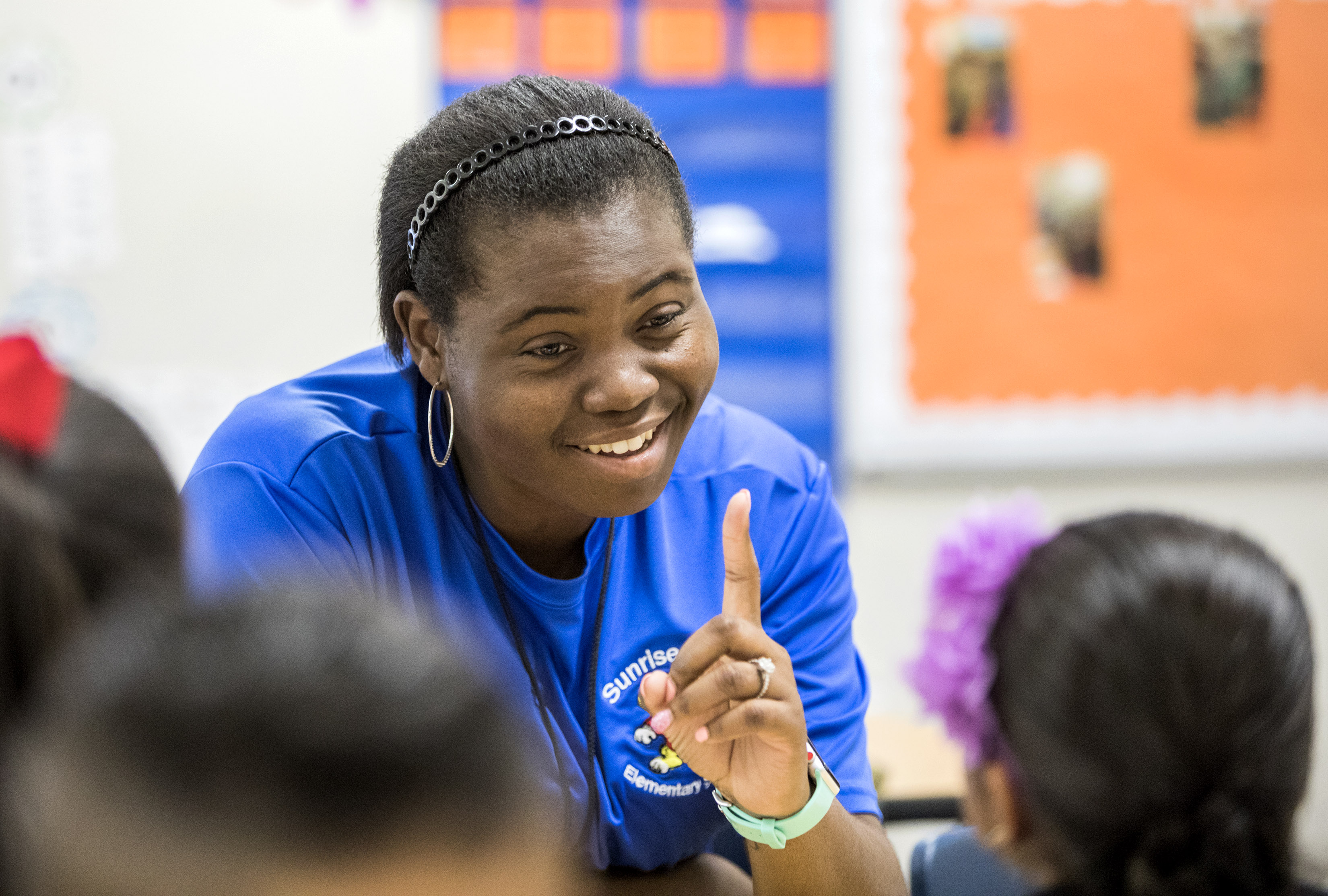
Perennial challenges
Before the costume-clad students pile outside for an afternoon picnic celebrating their success, they’re brushing up on the new skills they need to master this year.
In Kinesha Manuel’s first-grade classroom, she’s handing out an environment-themed information flyer for parents.
“I’m going to ask you whether you want them in Spanish or English for your parents,” she says. “You understand? You only get one.”
About a third of the students request the Spanish-language version. They tuck the handout in their backpacks and head to various learning centers: Chromebooks with reading games, whiteboards and markers to practice spelling and writing sight words; and, last but not least, a basket of books. This is how they’ll occupy their time while Manuel tests students’ reading skills one by one.
Manuel calls 6-year-old Aliyah to her desk. The little girl knows the drill: Read the paragraph on the iPad out loud. But the first word stumps her.
After three seconds of silence, Manuel reads the word — “goodbye” — for her and makes a note. The next word is “mom.”
“Sound it out,” Manuel says.
Aliyah strings together the letter sounds in a way that turns the single-syllable word into one that takes several seconds to utter. But she gets it right. It will be the only word she correctly reads in the 60-second time frame. She misses seven others. Later, another girl reads 53 words with no trouble.
Manuel dutifully logs every child’s reading progress or setbacks, creating data that paint a portrait of each student’s ability level. She generally tests a low-level reader followed by a student with stronger reading skills — a tactic that provides a small bit of comfort for the person who, each year, inherits students with reading skills all over the map.
“It lessens my stress,” she says.
The wide range of reading skills isn't an indictment of kindergarten teachers. It's a problem that stems from a variety of factors, including lack of preschool, little parental involvement and, in some cases, a learning disability.
Some of her first-graders can read 100 sight words or more by late October. But others, like Aliyah, struggle to read a dozen of these common words, such as “the,” “it,” “want” and “where.” It’s a pressure that only educators can understand — the desire to see their students grow academically after the hours spent lesson-planning, teaching and molding the young minds in their classroom.
As Manuel wraps up her individual testing, two fourth-grade girls pop into her classroom and make a beeline for the bookshelf. They’re here to borrow books.
They’re still reading on a first-grade level.


